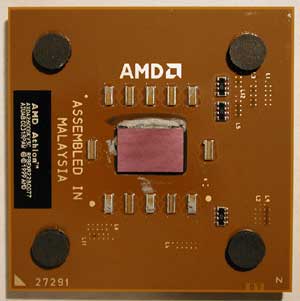Introduction, What's New?
Flashback to August 1999. Nearly 3 years ago to the day, AMD introduced their Athlon processor. This website had only been running a few months at that stage, but I remember from a gamer and hardware enthusiast's perspective, the collective jaw-dropping in the community. Intel's PentiumIII was out and about, having snuck from behind the coat-tails of the P2 and Intel's history of market dominance. We were overclocking them, we were watercooling them, we were playing games on them. In those days, if you were a hardcore gamer, you had a P3. If you couldn't afford one, you had a P2 or a Celeron. AMD, in the mind of the enthusiast and the gamer, made low-cost, low-heat and, most importantly, low-grunt chips. It must be said that AMD, with their K6 line, were largely ignored by the speed-obsessed. The Athlon changed all that. Within weeks there were hefty coolers and motherboards bristling with performance features and tweaking options. Fan websites sprung up and suddenly there were 2 camps on the scene. A real competitor had emerged and the Intel vs AMD battle had begun.
Jolt back to the present day. Intel has been taking a beating in the enthusiast market, with the Athlon having evolved through Thunderbird, Palomino and Thoroughbred cores. The P3 lingers on, but Intel's focus - and the market's with it - is on their newer Pentium IV product. Until recently, the gamers and enthusiast market had been little impressed with the P4. There's been a price penalty associated with Intel's offerings and, although the P4 overcomes this by ramping to ever-higher clockspeeds, performance clock-for-clock is dissapointing compared to the AthlonXP. However, in the last few months, Intel's Northwood-cored P4's have been attracting a lot of attention. The 533MHz (QDR) FSB chips have big speed out of the box and even more waiting for savvy overclockers. Intel's focus on RAMBUS has shifted to the cheaper and more readily-available DDR and a big range of attractive motherboard options has emerged, notably around their own i845E offering. Big price cuts from both sides have made them very competitive and slowly, like a fragment separating from a glacier, even some diehard AMD fans are starting to look at the P4 again.
Will this latest offering from AMD change that?

What's new?
It would be nice to say, on this almost-anniversary, that AMD have another huge surprise up their sleeve. In reality though, this latest offering is an evolutionary step along the same line that began 3 years ago. It's not Hammer, AMD's much-anticipated server/workstation line recently officially named Opteron. It's not Barton, the next in line after Thoroughbred, which depending which rumours you listen to may or may not be 333MHz (DDR) FSB and may or may not have 512kb of L2. This chip we have here today is a Thoroughbred-cored AthlonXP, with 266MHz (DDR) FSB, 256KB of L2 cache and the same Socket462 interface.
Note however, the lack of a heatspreader and the tiny core due to the .13 micron process used in fabrication. The core has no writing on it - whether this is due to thermal interface concerns or this being a preproduction sample I don't know. Maybe AMD decided it was just too small to write on anymore. The 0.13 micron process appeared with the first (XP2200+) Thoroughbreds and does bring lower voltage and less heat, both good things.
In an email from AMD, they said: AMD has successfully implemented a process change for the "Thoroughbred" processor core that involved adding an additional layer of metal to reduce resistance and capacitance. AMD has also engineered additional decoupling capacitors to reduce electro magnetic interference. Finally, AMD always takes an active approach to rebalance and improve speed paths throughout the processor core design.
Most importantly of course - it has a core speed of 2.133GHz. Also released today is its 2400+ counterpart at 2.0GHz. This is an important milestone for AMD, with Intel pushing their P4 to 2.53GHz currently and the expected announcement of 2.66GHz and 2.8GHz parts soon. Of course, it's not fair to do a direct MHz-to-MHz comparison between two different CPU's. This has always been the case - in the old days, nobody would compare, say, DEC Alpha and Sun Sparc CPU's purely on clockspeed. There's a recognition that different CPU's achieve their performance goals in different ways. Intel's P4, with its super-long pipelines, is designed to scale to high core frequencies - but those pipelines bring a performance penalty. AMD's XP+ naming system is a reflection of that difference.
Finally, the L1 bridges are not laser-cut. I doubt this will remain true of the commercially-available units. The grey goo liberally sprinkled across the CPU is detritus from the huge thermal pad on the provided cooler.
Anyway, enough of the theory - let's see some real-world numbers. In the remainder of this review, I compare AMD's 2600+ 2.13GHz offering to Intel's current flagship, the 2.54GHz P4.
|


